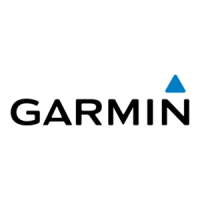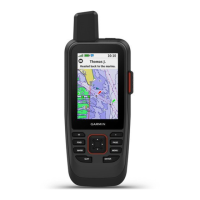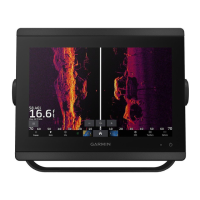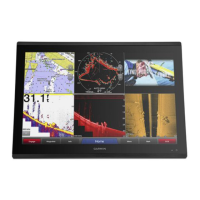Do you have a question about the Garmin GPSMAP 8610 and is the answer not in the manual?
Offers useful tips and shortcuts for operating the chartplotter efficiently.
Details on how the device acquires GPS satellite signals for location data.
Configuring chartplotter settings based on the selected boat type.
Securing the device with a PIN to prevent unauthorized use.
How to create custom pages by combining different data windows.
Adding custom SmartMode layouts to suit specific activities.
Customizing layouts and data displayed in combination and SmartMode pages.
Customizing pre-loaded presets and editing created presets.
Saving customized screen settings as a new preset.
Using voice commands to control the chartplotter with a compatible headset.
Steps to pair a wireless headset with the chartplotter for voice control.
List of voice commands for controlling the chartplotter's functions.
Information on using the GRID remote control with the chartplotter.
Instructions for pairing GRID devices with the chartplotter.
Connect a mobile device to the GPSMAP device using the ActiveCaptain app.
Setting up the device to receive notifications from a mobile device.
How notifications appear on the GPSMAP screen and available actions.
Accessing and managing notifications received on the chartplotter.
Download and install software updates using the ActiveCaptain app.
Download and transfer the latest chart updates using the ActiveCaptain app.
Configure the chartplotter's Wi-Fi network for wireless device connections.
Steps to connect wireless devices to the chartplotter's Wi-Fi network.
Instructions for pairing a wireless remote control with the chartplotter.
Steps to connect a wireless sensor, such as a wind sensor, to the chartplotter.
Guidance on setting and following a course to a selected point on the chart.
Information about optional premium charts and their advanced features.
Using AIS to identify and track other vessels and alerts.
Procedure for activating AIS targets for tracking and information.
Configuring a collision alarm for safety zones around the vessel.
Understanding AIS distress signals and their role in locating vessels.
Procedure for navigating to a distress signal transmission location.
Using Quickdraw Contours to create maps with contours and depth labels.
Linking to the community via the ActiveCaptain app.
Downloading maps from the community using the ActiveCaptain app.
Sharing your created contour maps with the community via ActiveCaptain.
Accessing the community via the Garmin Connect website.
Sharing your created contour maps with the community via Garmin Connect.
Downloading maps from the community using Garmin Connect.
Configuring settings for Garmin Quickdraw Contours recording and display.
How to search for destinations by name, including waypoints and routes.
How to set and follow a direct course to a selected destination.
Quickly marking the current location as a waypoint.
Creating waypoints by entering coordinates or selecting on the chart.
Procedure for marking a Man Overboard location for immediate assistance.
Modifying the name, symbol, position, or other details of a saved waypoint.
Changing the location of a saved waypoint.
Finding and navigating to saved waypoints.
Creating and navigating a route immediately from the current location.
Procedure for creating and saving a route with multiple turns.
Modifying the name or turns of an existing saved route.
Locating and navigating a previously created and saved route.
Feature that calculates the best path to a destination using chart data.
Steps to set up and follow an Auto Guidance path for navigation.
Procedure for creating and saving an Auto Guidance path.
Modifying an existing Auto Guidance path.
Modifying the name, color, or saving a saved track as a route/boundary.
Finding and navigating to a previously recorded track.
Steps for creating boundary shapes like areas, lines, and circles.
Modifying boundary appearance, lines, name, or alarm settings.
Configuring alarms to alert when approaching or entering a boundary.
Selecting the appropriate vessel type for sailing-specific features.
Using the device to improve performance at the start of a race.
Visual guidance for crossing the start line at the optimal time and speed.
Marking the port and starboard starting line marks for race guidance.
How to use the starting line guidance feature during a sailing race.
Starting and synchronizing the race timer for sailing events.
Configuring laylines for sailing races, requiring a wind sensor.
Steps to manually import polar table data from a memory card.
Displaying polar data in data fields for sailing performance analysis.
Overview of autopilot operation for sailboats, including heading and wind hold.
Maintaining a specific bearing relative to the current wind angle.
Steps to engage wind hold on the autopilot system.
Setting the autopilot to perform tacking and gybing maneuvers.
Detailed picture of fishing environment using ClearVü high-frequency sonar.
Shows a picture of what lies to the sides of the boat for search tool.
Overview of Panoptix sonar views for real-time underwater imaging.
Shows a live view of what is in front of or below the boat for fish and structures.
Shows a live view of surroundings and ahead of the boat in shallow water.
Setting the transducer type for proper sonar function.
Controlling detail and noise on the sonar screen by adjusting gain or brightness.
Adjusting color gain or contrast for better target visibility and contrast.
Accessing transducer and sonar return appearance settings.
Reducing interference and clutter on the sonar screen.
Configuring the appearance of the sonar screen, including color scheme.
Adjusting settings like Shift, Bottom Search Limit, and Transducer Installation.
Configuring settings related to transducer installation and performance.
Information on sonar frequencies and how they affect performance.
Choosing the appropriate frequencies to display on the sonar screen.
Setting up Panoptix sonar views, including angle and zoom.
Configuring settings for LiveVü Forward and FrontVü sonar views.
Setting an alarm for depth levels in front of the vessel.
Customizing the appearance of LiveVü and FrontVü sonar views.
Customizing the appearance of RealVü sonar views.
Configuring installation settings for Panoptix transducers.
Compensating forward distance readings for transducer installation location.
Calibrating the internal compass for Panoptix transducers.
Configuring gain, depth range, and forward range for LiveScope/Perspective.
Setting up appearance, layout, and noise rejection for LiveScope/Perspective.
Customizing the appearance of LiveScope and Perspective sonar screens.
Steps to connect and transmit radar signals.
Adjusting the radar range to view targets at different distances.
Using Doppler effect to detect and highlight moving targets.
Setting up a guard zone to alert when anything enters a specified area.
Defining a circular guard zone that surrounds the boat.
Defining a partial guard zone that does not completely surround the boat.
Mini-automatic radar plotting aid for target identification and collision avoidance.
Automatically acquiring MARPA targets based on MotionScope, guard zones, or boundaries.
Tagging an object to make it a MARPA target.
Adjusting the diameter of the VRM and the angle of the EBL.
Measuring the range and bearing to a target object on the radar screen.
Optimizing the radar display for each radar mode.
Adjusting radar gain automatically or manually for optimal performance.
Automatically adjusting radar gain based on conditions.
Manually adjusting radar gain for optimal performance.
Adjusting sea clutter, rain clutter, and scan averaging.
Adjusting sea clutter appearance due to choppy sea conditions.
Adjusting rain clutter appearance.
Accessing radar options like MotionScope, Echo Trails, and VRM/EBL.
Configuring radar source, chart display, orientation, and appearance.
Setting background color, foreground color, and brightness.
Information on installing and configuring the autopilot system.
Choosing the preferred source for heading data for the autopilot.
Enabling Shadow Drive to disengage autopilot by manual steering.
Steps to engage the autopilot to maintain heading.
Manually adjusting heading using the helm with autopilot engaged.
Adjusting heading using step steering mode on the chartplotter.
Using preset steering patterns for fishing and maneuvers.
Operating the autopilot using a GRID 20 remote control.
Connecting and controlling a Reactor autopilot remote control.
Steps to wirelessly pair a Reactor autopilot remote control.
Updating the remote control software using the chartplotter.
Information on controlling a compatible Yamaha autopilot system.
Configuring Yamaha autopilot settings like pattern, direction, and spacing.
Connecting the chartplotter wirelessly to a Garmin Force trolling motor.
Configuring settings like Calibrate, Anchor Gain, and Navigation Gain.
Calibrating the trolling motor compass before using autopilot features.
Enabling DSC features when connected to VHF radio.
Alerts for DSC distress calls received from the VHF radio.
Navigating to a vessel that has sent a distress call.
Handling MOB calls initiated from a VHF radio.
Initiating MOB or SOS calls from the chartplotter.
Navigating to the location of a tracked vessel.
Viewing engine and environmental information via gauges and graphs.
Accessing and viewing gauge pages for vessel information.
Customizing the data displayed in individual gauges.
Adding gauge pages, changing layouts, and customizing gauge data.
Configuring upper/lower limits and desired operating ranges for gauges.
Enabling the chartplotter to display engine status alarms.
Connecting an inReach device to view, reply, and send preset messages.
Monitoring and controlling vessel circuits like lights via digital switching.
Controlling audio playback through the chartplotter.
Accessing SiriusXM satellite radio with compatible stereo and tuner.
Setting parameters for Auto Guidance path calculation.
Setting how close the Auto Guidance line is placed to the shore.
Configuring navigation and system alarms.
Setting alarms for shallow water, deep water, fish, and contour detection.
Compensating depth readings for transducer location relative to the keel.
Updating built-in maps using Garmin Express and a memory card.
Updating built-in charts using Garmin Express and a memory card.
Information on updating device software using ActiveCaptain or Garmin Express.
Copying software updates to a memory card using Garmin Express.
Installing software updates onto the device using a memory card.
Solutions for common device issues.
Troubleshooting steps for devices unable to acquire GPS signals.
Troubleshooting power issues when the device won't turn on or stays off.
Troubleshooting waypoint creation issues related to map datum and position format.
Technical specifications for the GPSMAP 8x10 model.
Technical specifications for the GPSMAP 8x12 model.
Technical specifications for the GPSMAP 8x16 model.
Technical specifications for the GPSMAP 8x17 model.
Technical specifications for the GPSMAP 8x22 model.
Technical specifications for the GPSMAP 8x24 model.
Technical specifications for the GPSMAP 8700 model.
Offers useful tips and shortcuts for operating the chartplotter efficiently.
Details on how the device acquires GPS satellite signals for location data.
Configuring chartplotter settings based on the selected boat type.
Securing the device with a PIN to prevent unauthorized use.
How to create custom pages by combining different data windows.
Adding custom SmartMode layouts to suit specific activities.
Customizing layouts and data displayed in combination and SmartMode pages.
Customizing pre-loaded presets and editing created presets.
Saving customized screen settings as a new preset.
Using voice commands to control the chartplotter with a compatible headset.
Steps to pair a wireless headset with the chartplotter for voice control.
List of voice commands for controlling the chartplotter's functions.
Information on using the GRID remote control with the chartplotter.
Instructions for pairing GRID devices with the chartplotter.
Connect a mobile device to the GPSMAP device using the ActiveCaptain app.
Setting up the device to receive notifications from a mobile device.
How notifications appear on the GPSMAP screen and available actions.
Accessing and managing notifications received on the chartplotter.
Download and install software updates using the ActiveCaptain app.
Download and transfer the latest chart updates using the ActiveCaptain app.
Configure the chartplotter's Wi-Fi network for wireless device connections.
Steps to connect wireless devices to the chartplotter's Wi-Fi network.
Instructions for pairing a wireless remote control with the chartplotter.
Steps to connect a wireless sensor, such as a wind sensor, to the chartplotter.
Guidance on setting and following a course to a selected point on the chart.
Information about optional premium charts and their advanced features.
Using AIS to identify and track other vessels and alerts.
Procedure for activating AIS targets for tracking and information.
Configuring a collision alarm for safety zones around the vessel.
Understanding AIS distress signals and their role in locating vessels.
Procedure for navigating to a distress signal transmission location.
Using Quickdraw Contours to create maps with contours and depth labels.
Linking to the community via the ActiveCaptain app.
Downloading maps from the community using the ActiveCaptain app.
Sharing your created contour maps with the community via ActiveCaptain.
Accessing the community via the Garmin Connect website.
Sharing your created contour maps with the community via Garmin Connect.
Downloading maps from the community using Garmin Connect.
Configuring settings for Garmin Quickdraw Contours recording and display.
How to search for destinations by name, including waypoints and routes.
How to set and follow a direct course to a selected destination.
Quickly marking the current location as a waypoint.
Creating waypoints by entering coordinates or selecting on the chart.
Procedure for marking a Man Overboard location for immediate assistance.
Modifying the name, symbol, position, or other details of a saved waypoint.
Changing the location of a saved waypoint.
Finding and navigating to saved waypoints.
Creating and navigating a route immediately from the current location.
Procedure for creating and saving a route with multiple turns.
Modifying the name or turns of an existing saved route.
Locating and navigating a previously created and saved route.
Feature that calculates the best path to a destination using chart data.
Steps to set up and follow an Auto Guidance path for navigation.
Procedure for creating and saving an Auto Guidance path.
Modifying an existing Auto Guidance path.
Modifying the name, color, or saving a saved track as a route/boundary.
Finding and navigating to a previously recorded track.
Steps for creating boundary shapes like areas, lines, and circles.
Modifying boundary appearance, lines, name, or alarm settings.
Configuring alarms to alert when approaching or entering a boundary.
Selecting the appropriate vessel type for sailing-specific features.
Using the device to improve performance at the start of a race.
Visual guidance for crossing the start line at the optimal time and speed.
Marking the port and starboard starting line marks for race guidance.
How to use the starting line guidance feature during a sailing race.
Starting and synchronizing the race timer for sailing events.
Configuring laylines for sailing races, requiring a wind sensor.
Steps to manually import polar table data from a memory card.
Displaying polar data in data fields for sailing performance analysis.
Overview of autopilot operation for sailboats, including heading and wind hold.
Maintaining a specific bearing relative to the current wind angle.
Steps to engage wind hold on the autopilot system.
Setting the autopilot to perform tacking and gybing maneuvers.
Detailed picture of fishing environment using ClearVü high-frequency sonar.
Shows a picture of what lies to the sides of the boat for search tool.
Overview of Panoptix sonar views for real-time underwater imaging.
Shows a live view of what is in front of or below the boat for fish and structures.
Shows a live view of surroundings and ahead of the boat in shallow water.
Setting the transducer type for proper sonar function.
Controlling detail and noise on the sonar screen by adjusting gain or brightness.
Adjusting color gain or contrast for better target visibility and contrast.
Accessing transducer and sonar return appearance settings.
Reducing interference and clutter on the sonar screen.
Configuring the appearance of the sonar screen, including color scheme.
Adjusting settings like Shift, Bottom Search Limit, and Transducer Installation.
Configuring settings related to transducer installation and performance.
Information on sonar frequencies and how they affect performance.
Choosing the appropriate frequencies to display on the sonar screen.
Setting up Panoptix sonar views, including angle and zoom.
Configuring settings for LiveVü Forward and FrontVü sonar views.
Setting an alarm for depth levels in front of the vessel.
Customizing the appearance of LiveVü and FrontVü sonar views.
Customizing the appearance of RealVü sonar views.
Configuring installation settings for Panoptix transducers.
Compensating forward distance readings for transducer installation location.
Calibrating the internal compass for Panoptix transducers.
Configuring gain, depth range, and forward range for LiveScope/Perspective.
Setting up appearance, layout, and noise rejection for LiveScope/Perspective.
Customizing the appearance of LiveScope and Perspective sonar screens.
Steps to connect and transmit radar signals.
Adjusting the radar range to view targets at different distances.
Using Doppler effect to detect and highlight moving targets.
Setting up a guard zone to alert when anything enters a specified area.
Defining a circular guard zone that surrounds the boat.
Defining a partial guard zone that does not completely surround the boat.
Mini-automatic radar plotting aid for target identification and collision avoidance.
Automatically acquiring MARPA targets based on MotionScope, guard zones, or boundaries.
Tagging an object to make it a MARPA target.
Adjusting the diameter of the VRM and the angle of the EBL.
Measuring the range and bearing to a target object on the radar screen.
Optimizing the radar display for each radar mode.
Adjusting radar gain automatically or manually for optimal performance.
Automatically adjusting radar gain based on conditions.
Manually adjusting radar gain for optimal performance.
Adjusting sea clutter, rain clutter, and scan averaging.
Adjusting sea clutter appearance due to choppy sea conditions.
Adjusting rain clutter appearance.
Accessing radar options like MotionScope, Echo Trails, and VRM/EBL.
Configuring radar source, chart display, orientation, and appearance.
Setting background color, foreground color, and brightness.
Information on installing and configuring the autopilot system.
Choosing the preferred source for heading data for the autopilot.
Enabling Shadow Drive to disengage autopilot by manual steering.
Steps to engage the autopilot to maintain heading.
Manually adjusting heading using the helm with autopilot engaged.
Adjusting heading using step steering mode on the chartplotter.
Using preset steering patterns for fishing and maneuvers.
Operating the autopilot using a GRID 20 remote control.
Connecting and controlling a Reactor autopilot remote control.
Steps to wirelessly pair a Reactor autopilot remote control.
Updating the remote control software using the chartplotter.
Information on controlling a compatible Yamaha autopilot system.
Configuring Yamaha autopilot settings like pattern, direction, and spacing.
Connecting the chartplotter wirelessly to a Garmin Force trolling motor.
Configuring settings like Calibrate, Anchor Gain, and Navigation Gain.
Calibrating the trolling motor compass before using autopilot features.
Enabling DSC features when connected to VHF radio.
Alerts for DSC distress calls received from the VHF radio.
Navigating to a vessel that has sent a distress call.
Handling MOB calls initiated from a VHF radio.
Initiating MOB or SOS calls from the chartplotter.
Navigating to the location of a tracked vessel.
Viewing engine and environmental information via gauges and graphs.
Accessing and viewing gauge pages for vessel information.
Customizing the data displayed in individual gauges.
Adding gauge pages, changing layouts, and customizing gauge data.
Configuring upper/lower limits and desired operating ranges for gauges.
Enabling the chartplotter to display engine status alarms.
Connecting an inReach device to view, reply, and send preset messages.
Monitoring and controlling vessel circuits like lights via digital switching.
Controlling audio playback through the chartplotter.
Accessing SiriusXM satellite radio with compatible stereo and tuner.
Setting parameters for Auto Guidance path calculation.
Setting how close the Auto Guidance line is placed to the shore.
Configuring navigation and system alarms.
Setting alarms for shallow water, deep water, fish, and contour detection.
Compensating depth readings for transducer location relative to the keel.
Updating built-in maps using Garmin Express and a memory card.
Updating built-in charts using Garmin Express and a memory card.
Information on updating device software using ActiveCaptain or Garmin Express.
Copying software updates to a memory card using Garmin Express.
Installing software updates onto the device using a memory card.
Solutions for common device issues.
Troubleshooting steps for devices unable to acquire GPS signals.
Troubleshooting power issues when the device won't turn on or stays off.
Troubleshooting waypoint creation issues related to map datum and position format.
Technical specifications for the GPSMAP 8x10 model.
Technical specifications for the GPSMAP 8x12 model.
Technical specifications for the GPSMAP 8x16 model.
Technical specifications for the GPSMAP 8x17 model.
Technical specifications for the GPSMAP 8x22 model.
Technical specifications for the GPSMAP 8x24 model.
Technical specifications for the GPSMAP 8700 model.
| Display Resolution | 1280 x 800 pixels |
|---|---|
| Touchscreen | Yes |
| Water Resistance | IPX7 |
| GPS Receiver | Yes |
| Chartplotter | Yes |
| Wi-Fi Connectivity | Yes |
| Bluetooth Connectivity | Yes |
| NMEA 0183 Input Ports | 2 |
| NMEA 0183 Output Ports | 2 |
| NMEA 2000 Ports | 1 |
| NMEA 2000 Support | Yes |
| Built-in Sounder | No |
| Compatible with Garmin Panoptix | Yes |
| Display Size | 10 inches |
| Mounting Options | Flush mount |
| Power Consumption | 12 VDC |
| Preloaded Maps | BlueChart g3 |











